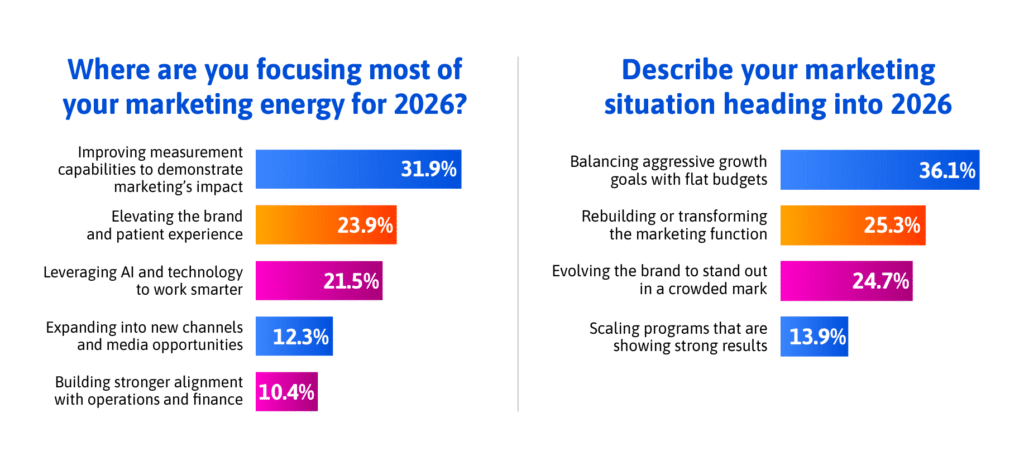Scaling Up is Cardinal’s annual summit on performance marketing in healthcare, and this year set a new benchmark.
Table of Contents
We brought together 50 speakers, 25 sessions, and more than 1,400 registrants, representing some of the most innovative minds in healthcare marketing. Making the event free for the first time opened the doors for even more participation, and more importantly, more shared learning.
That learning couldn’t have come at a better time. Marketers are under pressure like never before. Budgets are flat, patient demand is unpredictable, and AI is rewriting how we think about everything from SEO to media targeting. The one thing everyone agreed on: every dollar now has to work harder and provably drive growth.

During our opening poll, 36% of attendees said they’re trying to grow while working with flat budgets. 32% said their top focus for 2026 is improving measurement capabilities to show impact and invest smarter. Both signal the same shift: visibility, alignment, and accountability are now the core levers of growth.
As Heartland Dental’s CMO Sherianne James put it, “The goal [is] not just driving patient volume, but driving the right patient mix in our providers’ doors.”
That theme echoed throughout the event. Whether it was data visibility, martech consolidation, or testing new channels, the message was clear: growth in 2026 will be built on disciplined infrastructure, not guesswork.
Here are the six takeaways that stood out most.
1. Martech sprawl must be managed
For multi-location healthcare groups, martech sprawl is inevitable. Each acquisition adds another layer of CRMs, call trackers, and analytics tools. Over time, that creates fragmented data, broken attribution, and teams stuck in reporting quicksand.
In our panel Scaling Patient Acquisition in Complex Brand Architectures, Specialty Dental Brands’ Director of Digital Marketing Rowan Harper shared how this challenge plays out:
“Our PMSs, especially, and phone systems are quite disparate… Disparate data is the biggest challenge because you have to figure out how multiple disparate sources equate to a single report.”
He’s right. Even if every practice maintains its own tracking, marketers need a single source of truth to make meaningful decisions.
Action Step:
Whether before an acquisition or to kick off a centralization project, start with a structured audit. Map all systems, data flows, and dependencies before merging anything. Then, centralize and consolidate accounts, followed by location-level customization. Build a unified naming convention and reporting framework early. Remember, it’s far easier to standardize early than to clean up later. But as Smile Partners’ Digital Marketing Director, Ashley Minaudo, reminded us, “Don’t rush into execution. Really start by listening and diagnosing… Every office and brand… has its own ecosystem.”
2. Centralization enables better performance
Centralization drives not only efficiency, but also accountability and ultimately, better performance.
In the session Inside the Marketing Machine Powering 500+ Locations, AEG Vision’s CMO Rachelle Kuebler-Weber shared how moving inbound calls to a centralized call center transformed performance:
“We saw a 60% higher answer rate through our call center. These are high-intent patients — if practices miss those calls, competitors win.”
AEG also consolidated 60 parent brands under a single analytics and call-tracking framework. That centralization enabled them to analyze performance across the system and identify where patient conversions were being won or lost.
Action Step:
Centralize call handling wherever possible, and measure beyond volume. Track answer rates, scheduling efficiency, and conversion to booked appointments. Analyze call recordings to spot missed opportunities and poor lead quality, then feed those insights back into media optimization and staff coaching. When marketing controls both data and the patient journey, performance multiplies.
3. Data visibility unlocks C-suite trust
Marketing earns credibility when it can show exactly how it drives growth. Without clear attribution, the C-suite often sees marketing as a cost center rather than a growth engine.

In Scaling Growth Through Smarter Investment, Action Behavior Centers’ CMO Matt Stringer summed up the turning point:
“I didn’t come in and promise perfect performance. I really just promised visibility. I think, ultimately, once our leadership and our C-suite trusted that process, that really gave us the room to grow, to scale, and to test.”
By connecting CRM, ad platform, and call-tracking data, ABC could directly tie campaigns to tours and patient starts, transforming how finance viewed its budget.
Action Step:
Audit every data source that touches the patient journey, from ad click to appointment booked. Then integrate those systems into a shared dashboard that shows ROI across channels. When leadership can see the numbers the same way you do, marketing shifts from being questioned to being trusted and funded.
4. Test strategically to drive growth
Diversifying beyond Google is essential, but without disciplined testing, new channels become expensive distractions. Growth comes from structured experimentation that is grounded in data, not guesswork.
In Marketing’s Seat at the Table: Winning the C-Suite’s Confidence, Dayton Children’s Hospital’s Corporate Director of Strategic Marketing, Harriet Meehan, emphasized how testing should work:
“We’re going to launch this thing, and we’re going to test. This is the exact result that we’re looking for. This is what the impact will be.”
Testing done right allows teams to scale what works and cut what doesn’t, without losing C-suite confidence.
Action Step:
Reserve 10–20% of your media budget for structured testing. Document every experiment with a hypothesis, budget, and target metric (e.g., reduced CAC, improved lead-to-appointment rate). Use control markets to measure incremental lift, and maintain a shared “test log” so insights compound over time. A disciplined testing culture turns curiosity into predictable growth.
5. Foundational systems take time (but are worth it)
Every marketer wants real-time dashboards and revenue forecasting, but foundational systems take time to build.
Pelvic Rehabilitation Medicine’s VP of Growth, Theresa Porcaro, captured this reality in Forecasting Growth With the Right Data Infrastructure:
“One of our biggest challenges was building marketing from the ground up, but also (as a PE-backed company), data proving it. I won’t say it happened overnight… I will say that over about two years, I can now predict revenue and forecast leads in our 14 locations.”
Two years may sound long, but that kind of infrastructure—connecting Salesforce, eClinicalWorks, and phone systems into Power BI—enables them to automate nurture flows and accurately model ROI.
Action Step:
Treat data infrastructure as a long-term investment. Start by auditing what’s in place, identifying the core metrics you need to forecast growth, and building a roadmap for integration. Align with operations and finance from day one to ensure every system serves business goals. Progress will be gradual, but the payoff is exponential.
6. Marketing must own a number
This was the unifying message across nearly every session: marketers who want a seat at the table must own a number. Whether it’s new patient volume, CAC, or revenue contribution, the marketing function only earns influence when it’s tied to measurable business outcomes. And in some ways, that’s what all the other tips have been leading you to.

In Measuring What Matters: ROI and Attribution in Healthcare, Duly Health and Care’s SVP of Marketing Monu Kalsi said it best:
“Own a number or numbers. Make sure you understand how you directly or indirectly influence or drive that metric… You have to connect those dots in order to keep your job.”
That shift, from dispassionately reporting on impressions or clicks to owning and reporting on a measurable business outcome directly tied to profitability, has become the new baseline for credibility with the C-suite.
Action Step:
Identify the metric that most clearly connects marketing to business impact. Build dashboards that translate campaign data into revenue, patient volume, or LTV. Then report those metrics in the language of finance. The more marketing speaks in business terms, the more indispensable it becomes to the C-suite.
Looking ahead to 2026
Scaling Up 2025 reinforced what we’ve seen across our client base: the healthcare marketers leading growth in 2026 will be the ones who invest in visibility, alignment, and accountability.
Before chasing the next shiny tool or AI dashboard, focus on your foundation: unified martech systems, trustworthy data, and clear measurement frameworks. Once those are in place, the rest of your marketing strategy becomes easier to scale, optimize, and prove.
Because at the end of the day, healthcare marketing isn’t just about generating leads, it’s about driving measurable growth that the entire organization can see and believe in.

